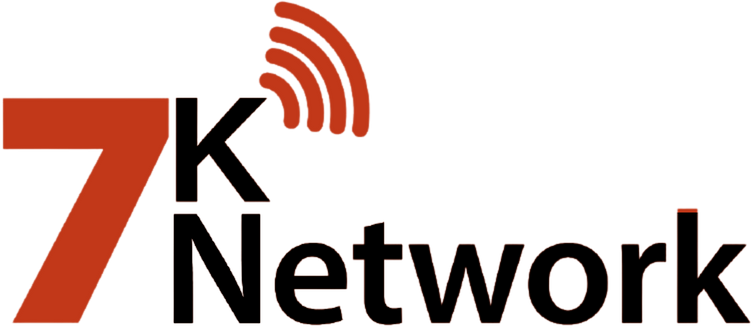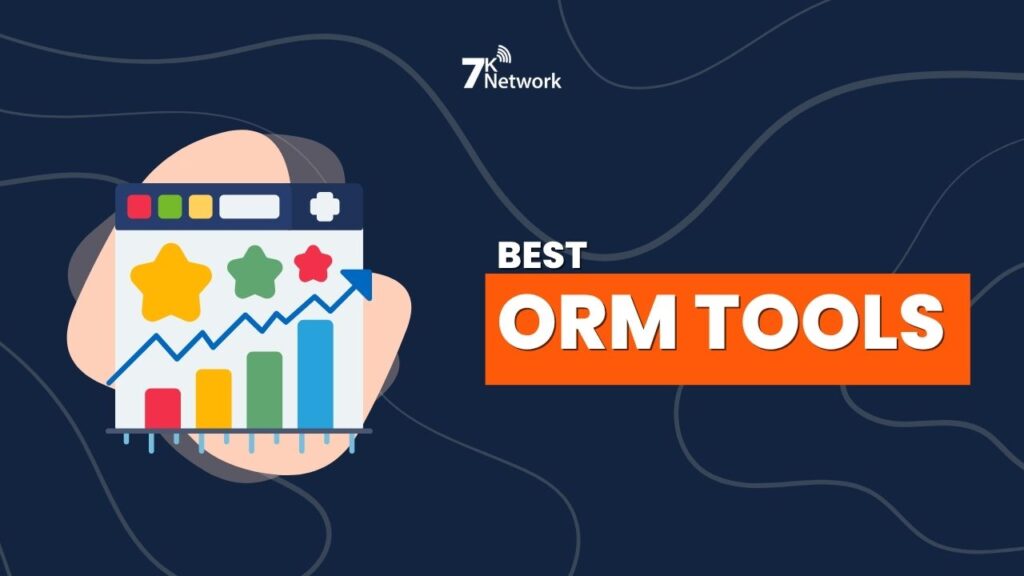Object-Relational Mapping (ORM) software is a key part of computer programming these days as it allows applications to talk to databases effortlessly. Rather than having to write complex SQL queries by hand, programmers are now able to use ORMs to interact with database records through simple-to-use programming abstractions. Not only is this more time-efficient, but it decreases errors and makes the code more maintainable.
Following is the best suggested 15 list of best ORM tools, fine-tuned for developers, backend architects, and software engineers that seek efficient as well as scalable database solutions. The tools are chosen to keep in mind factors such as support for languages, user-friendliness, performance, feature set, community support, framework support, and flexibility. Be it for creating enterprise-level applications or lightweight web services, the proper ORM can highly reduce your development process.
Criteria for Selecting the Best ORM Tools
While choosing the best ORM tools, certain essential factors are taken into consideration to provide reliability, functionality, and usability. Compatibility with different languages is given priority, whereby tools supporting dominant languages such as Java, Python, C#, PHP, TypeScript, Go, and Ruby are chosen. Readability is also given importance, such as ease of interfaces, minimal boilerplate code, and documentation.
Performance and scalability are a top concern, particularly in handling large volumes of data and complex queries at optimal speeds. Rich feature sets (enabling migrations, relationships, and transactions), community support, and customization are other major requirements. Integration with major frameworks and cost-friendliness, ideally low-cost or open-source, also play a crucial role in choosing the best ORM tools for any number of development projects.
List of the 15 best ORM tools
1. Hibernate (Java)
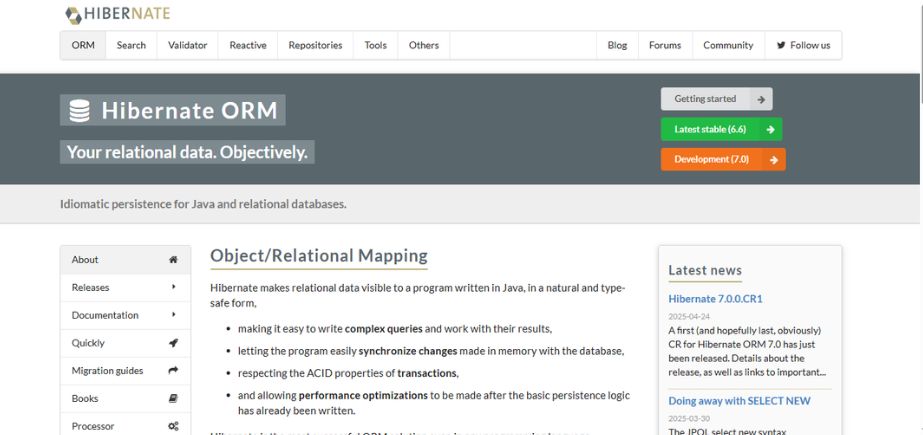
Hibernate is a well-established Java ORM tool that presents database access as Java objects. Hibernate minimizes the number of SQL query writes since one can write against HQL (Hibernate Query Language). Hibernate also supports intrinsic lazy loading, caching, and automatic creation of schema and thus finds proper use in enterprise-level applications. Hibernate also has support for various databases and frameworks such as Spring. Hibernate implements JPA specifications and is largely used because it is fast, scalable, and can manage complicated relationships between the data, hence is considered one of the best ORM tools in the market.
Key Features:
- Supports Hibernate Query Language
- Automatic schema generation
- Lazy and eager loading
- Caching and performance tuning options
Pros:
- Reduces boilerplate JDBC code
- Integrates well with Spring Framework
Cons:
- Steep learning curve
- Can be complex for small projects
Pricing:
Free & Open Source
Who should use it?
Java developers are building scalable enterprise applications.
2. Entity Framework (C#/.NET)
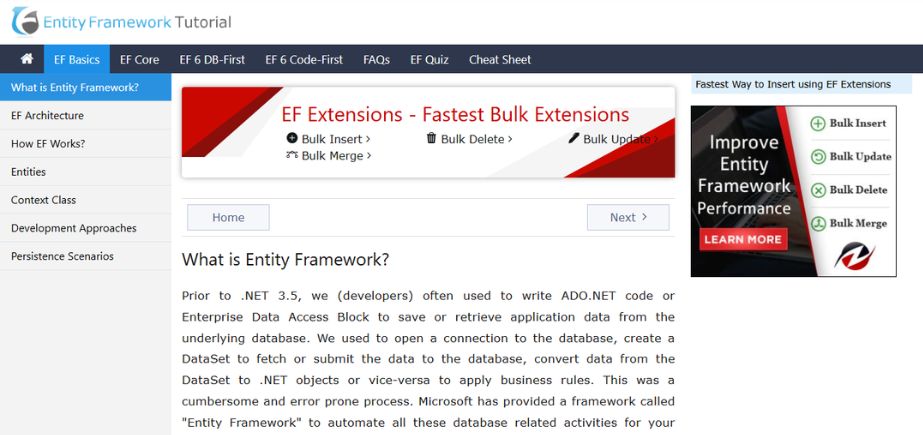
Entity Framework is Microsoft’s ORM for .NET applications to write data using domain-specific objects. Entity Framework supports code-first as well as database-first development and works well with Visual Studio. EF makes CRUD operations easier and keeps strong type safety intact while dealing with complex entity relationships. LINQ support, lazy/eager loading, and managing migrations add to productivity. It has support for many databases like SQL Server, MySQL, and PostgreSQL, and hence is a favorite among .NET developers developing data-driven enterprise applications.
Key Features:
- LINQ support for queries
- Code First and Database First approaches
- Automatic change tracking
- Integration with Visual Studio
Pros:
- Easy to use with Visual Studio
- Strong documentation and support
Cons:
- Not ideal for very complex queries
- Can be slower than raw SQL
Pricing:
Free (part of .NET)
Who should use it?
.NET developers building desktop or web apps with relational databases.
3. SQLAlchemy (Python)
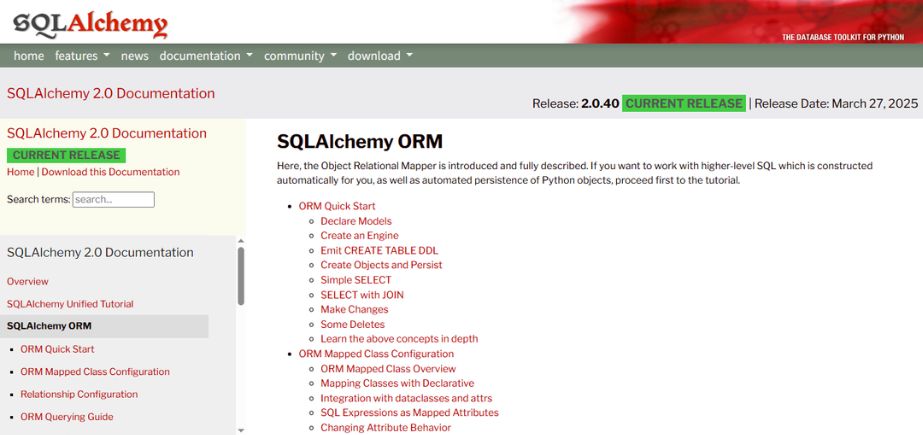
SQLAlchemy is a Python abstracted ORM and offers a complete set of functionalities to connect databases. Both object-oriented as well as extremely expressive SQL language expression abilities assist developers in gaining effective fine-grained control over query statements. In addition, SQLAlchemy provides the feature of being able to map classes against tables as well as complex relation handling easily. It’s largely loved for being flexible, and performance-oriented, and for supporting several databases such as PostgreSQL, SQLite, and MySQL. Whether you’re a high-level abstraction or low-level SQL enthusiast, SQLAlchemy is supported by both to make it a favorite among Python developers.
Key Features:
- Supports ORM and SQL Expression Language
- Built-in schema generation
- Transaction management
- Support for multiple database engines
Pros:
- Highly customizable
- Works well with complex schemas
Cons:
- Steeper learning curve for beginners
- Verbose for simple tasks
Pricing:
Free & Open Source
Who should use it?
Python developers need a flexible ORM with raw SQL control.
4. Django ORM (Python)
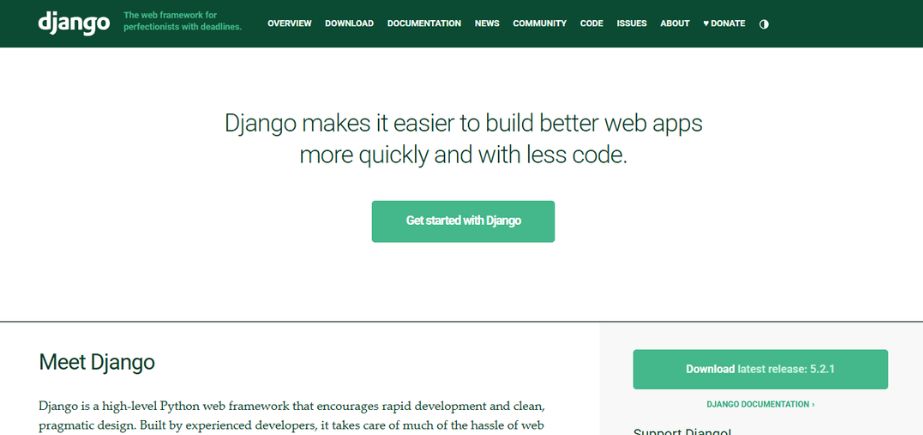
Django ORM is a native part of the Django web framework, which makes database interaction possible with Python programming. It constructs SQL queries automatically and offers a neat API to work with databases based on models. With the support for migration, relations, and chaining, Django ORM is easy to use even for newbies, but with sufficient power for experts. Django ORM is supported by a huge range of databases like PostgreSQL, MySQL, and SQLite. Django ORM’s strong adherence to the Django framework makes it possible for developers to develop and host web applications in an orderly manner, following the principles of DRY and MVC.
Key Features:
- Automatically handles table creation and migrations
- High-level API for querying
- Works seamlessly with Django Admin
- Supports relationships and model inheritance
Pros:
- Easy to use and understand
- Integrated with Django’s ecosystem
Cons:
- Limited flexibility outside Django
- Less control over raw SQL queries
Pricing:
Free & Open Source
Who should use it?
Developers building web apps using Django.
5. TypeORM (TypeScript / Node.js)
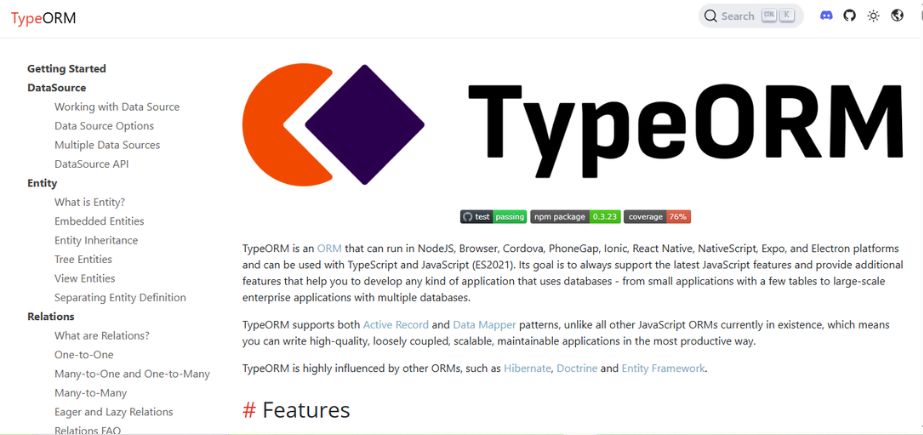
TypeORM is a TypeScript and JavaScript modern ORM that covers both Active Record and Data Mapper patterns. It supports popular databases such as MySQL, PostgreSQL, SQLite, and MongoDB. TypeORM supports developers in defining database models through decorators and strongly typed classes, making development faster and code more reliable. It has auto-migrations, lazy loading, and works smoothly with Node.js frameworks such as NestJS. Perfect for TypeScript-dominant projects, TypeORM presents a mature set of tools to handle relationships, transactions, and schema synchronization effectively.
Key Features:
- Active Record and Data Mapper support
- Decorators for defining models
- Schema migration support
- Works with PostgreSQL, MySQL, SQLite, and more
Pros:
- Strong TypeScript support
- Clean syntax with decorators
Cons:
- Can be buggy with newer updates
- Documentation could be better
Pricing:
Free & Open Source
Who should use it?
Node.js and TypeScript developers who prefer strong typing.
6. Sequelize (Node.js)
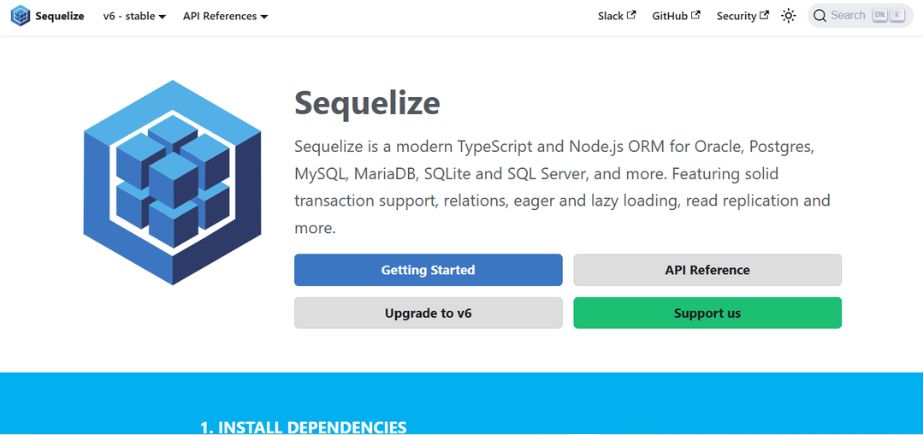
Sequelize is an ORM that provides Node.js promise-based functionality to reduce and streamline database operations. Sequelize supports MySQL, PostgreSQL, SQLite, and MSSQL databases and accommodates plain syntax in model definition and building queries. Sequelize provides facilities including migration, eager/lazy loading, validation, and association management. Sequelize is the most effectively utilized due to its high flexibility and community backing. Regardless of whether you are creating REST APIs or complete stack applications, Sequelize simplifies data management within Node.js applications and is also easily compatible with frameworks such as Express.js.
Key Features:
- Works with PostgreSQL, MySQL, SQLite, MSSQL
- Model-based design
- Associations, hooks, and validations
- Query builder with promise support
Pros:
- Easy to learn and implement
- Rich documentation and examples
Cons:
- Limited support for complex queries
- Migrations can be tricky
Pricing:
Free & Open Source
Who should use it?
Node.js developers looking for a quick and simple ORM solution.
7. Doctrine (PHP)
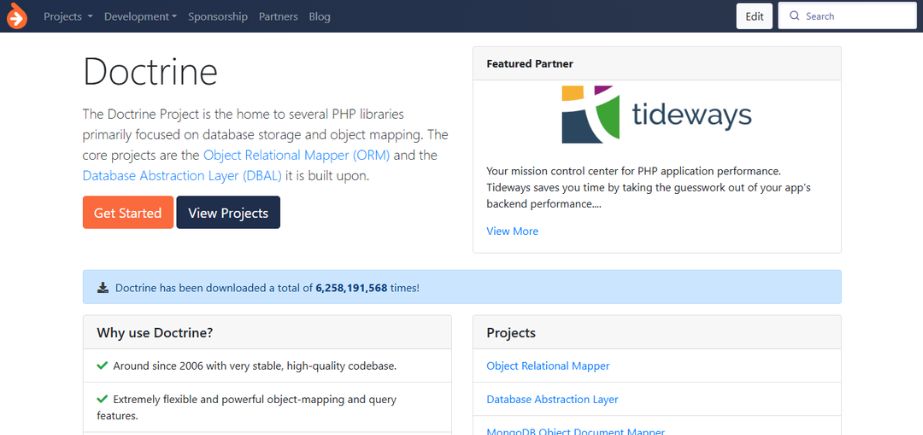
Doctrine is a robust PHP ORM that is widely used in Symfony and other PHP frameworks. It strictly adheres to the Data Mapper pattern in the sense that business logic is separated from database access. Doctrine provides lazy loading, transactions, DQL (Doctrine Query Language), and entity lifecycle events at a higher level. Its database schema generation and migration support simplify the management of the database. Developers can map PHP classes to database tables through annotations or XML/YAML files. Doctrine’s flexibility and range of features make it worthy of enterprise-level PHP apps with complex data models.
Key Features:
- Data Mapper pattern
- Annotation and XML mapping
- Caching support
- QueryBuilder and DQL (Doctrine Query Language)
Pros:
- Very powerful for complex projects
- Database-agnostic
Cons:
- Overhead for small apps
- Steep learning curve
Pricing:
Free & Open Source
Who should use it?
PHP developers building complex, modular systems.
8. Eloquent (PHP – Laravel)
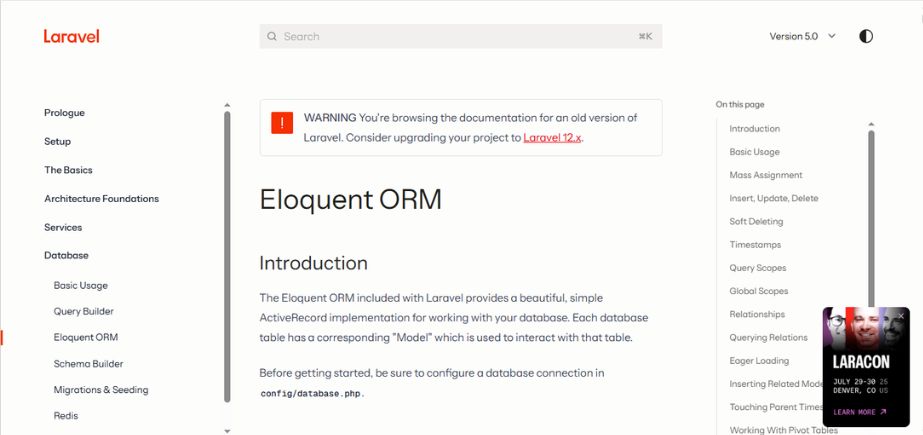
Eloquent is Laravel’s native ORM offering expressive and elegant database interaction. Using the Active Record pattern, allows developers to define models corresponding to database tables directly. Eloquent simplifies CRUD operations, relationships, and soft deletes using natural operations. Eloquent supports eager/lazy loading and query scopes natively as well. Eloquent, its migration feature in Laravel, and seeding functionality provide an excellent developer experience for PHP programmers who are looking to create well-healthy web applications with ease and effectiveness.
Key Features:
- Active Record pattern
- Relationship management (hasOne, belongsTo, etc.)
- Built-in query builder
- Automatic timestamping
Pros:
- Beautiful, readable syntax
- Tight integration with Laravel
Cons:
- Tied to Laravel
- Not ideal for complex DB logic
Pricing:
Free (part of Laravel).
Who should use it?
Laravel developers looking for rapid development and expressive code.
9. GORM (Go)
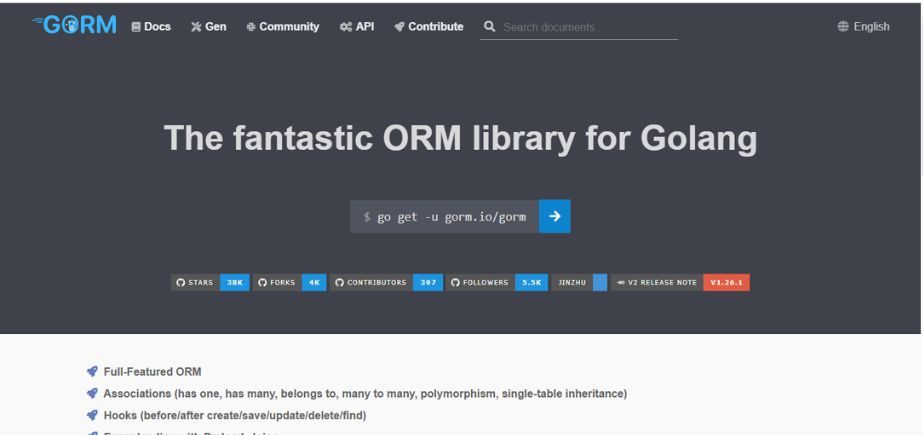
GORM is one of the best ORM tools for the Go programming language. It offers a developer-friendly interface to perform database operations with minimal boilerplate code. GORM supports features like auto migrations, associations, transactions, and hooks, making it a comprehensive ORM solution for Go. It is compatible with databases such as MySQL, PostgreSQL, SQLite, and SQL Server. Its struct-based design and convention-over-configuration approach help developers build scalable applications while maintaining readability and maintainability in their codebase.
Key Features:
- Auto migrations
- Relationship support
- Hooks, transactions, and callbacks
- CRUD and query chaining
Pros:
- Easy to integrate and use
- Active community and plugins
Cons:
- Slower with large datasets
- Less control over complex SQL
Pricing:
Free & Open Source
Who should use it?
Go developers looking for a full-featured ORM.
10. ActiveRecord (Ruby on Rails)
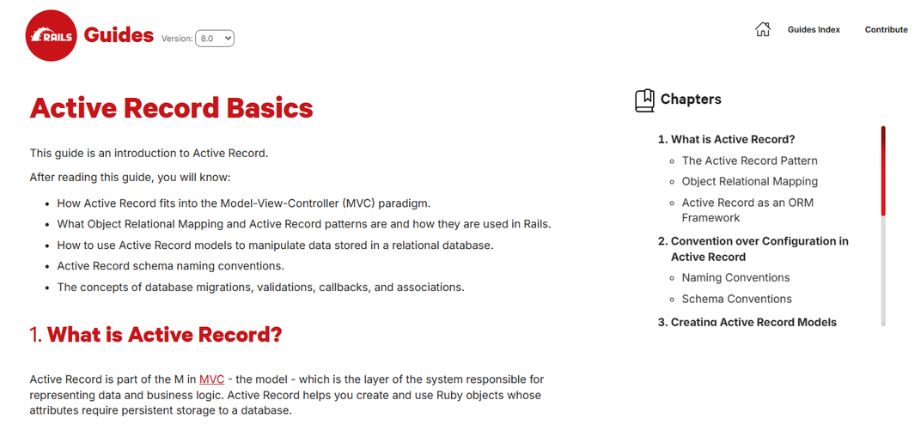
ActiveRecord is the ORM bundled with Ruby on Rails and adheres to the Active Record pattern of having models contain both data and behavior. It has a simple mapping of Ruby classes to database tables and strong support for associations, validation, and callbacks. ActiveRecord automates complex queries and supports migration, making the evolution of schema an easy task. Emphasizing convention over configuration, it enables rapid development of fault-tolerant web applications while maintaining a neat, readable syntax that dovetails well with Rails’ philosophy.
Key Features:
- Simple and intuitive syntax
- Convention over configuration
- Built-in migrations and validations
- Seamless Rails integration
Pros:
- Quick to implement
- Readable and expressive
Cons:
- Hard to decouple from Rails
- Not suited for complex DB interactions
Pricing:
Free (part of Rails)
Who should use it?
Ruby on Rails developers building database-backed web apps.
11. Bookshelf.js (Node.js)

Bookshelf.js is a Node.js JavaScript Object-Relational Mapping based on Knex.js. It provides relations like many-to-many, one-to-many, and polymorphic associations and thus is great for complex data structures. Bookshelf.js provides the ability for developers to insert custom methods for models and uses strong plugins to provide pagination, registry, and visibility. Bookshelf.js can be used on PostgreSQL, MySQL, and SQLite databases. Bookshelf’s light and modular nature appeals to developers who want a lightweight ORM that doesn’t compromise on relational features. Its Knex.js compatibility also enables raw SQL to be used when needed.
Key Features:
- Based on Backbone-style models
- Supports relations and eager loading
- Plugins for registry, pagination, etc.
- Works with PostgreSQL, MySQL, SQLite
Pros:
- Modular and extensible
- Built on top of Knex.js
Cons:
- Limited community size
- Documentation not as strong
Pricing:
Free & Open Source
Who should use it?
Developers looking for a flexible ORM with Knex.js.
12. Tortoise ORM (Python – Asyncio)
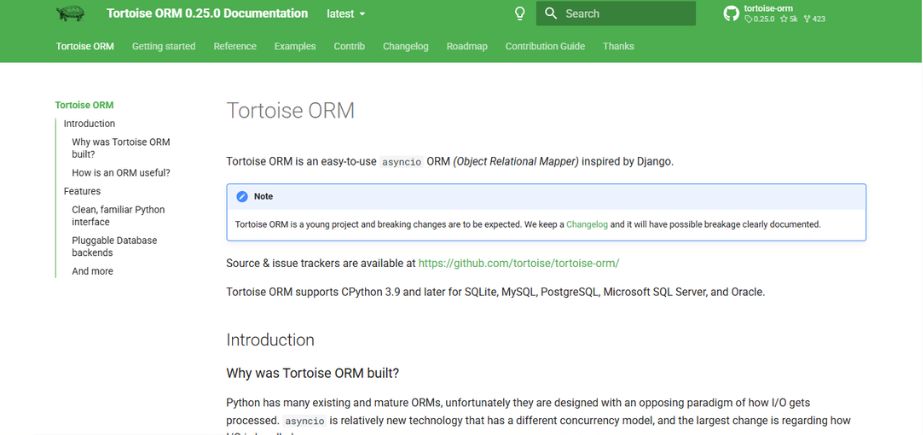
Tortoise ORM is an asynchronous Python ORM, implemented atop Django’s ORM but specifically for asyncio development. It includes automatic table creation, relationships, and query building with simple-to-read and minimalistic syntax. Tortoise ORM is designed to be used alongside contemporary Python applications and gets along well with frameworks such as FastAPI and Sanic. SQLite, PostgreSQL, and MySQL are supported. With migrations, data validation, and Pydantic model support, Tortoise is a perfect option for async web app developers in Python to create high-performance async web applications.
Key Features:
- Async support
- Easy-to-use model definitions
- Migration support via Aerich
- Relations and constraints handling
Pros:
- Lightweight and fast
- Django-like API
Cons:
- Smaller ecosystem
- Still maturing compared to others
Pricing:
Free & Open Source
Who should use it?
Python developers building async applications.
13. Peewee (Python)
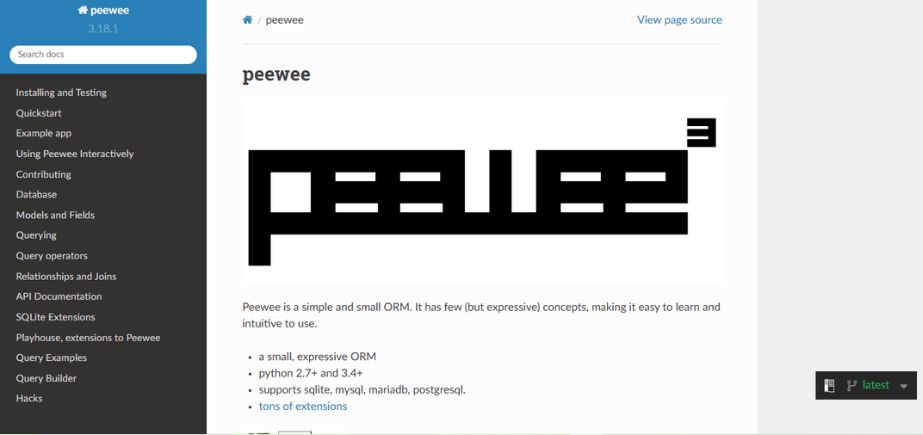
Peewee is a lightweight and expressive ORM for Python suitable for small- to mid-size applications. Peewee provides a simple and Pythonic way to use SQLite, PostgreSQL, and MySQL databases. With a minimal footprint, Peewee also provides sophisticated features like model relationships, pooling, and migrations. Peewee allows developers to write clean, readable code with minimum or even no setup. Ideal for developers who need a fast and effective database layer with little overhead relative to full-fledged ORMs, Peewee strikes the balance between feature set and simplicity.
Key Features:
- Lightweight and minimal
- Works with SQLite, PostgreSQL, MySQL
- Built-in migrations
- Model inheritance
Pros:
- Super easy to set up
- Fast performance
Cons:
- Lacks advanced features
- Not ideal for large applications
Pricing:
Free & Open Source
Who should use it?
Python developers building small apps or scripts.
14. MikroORM (TypeScript / Node.js)

MikroORM is a Data Mapper pattern implementation TypeScript ORM supporting clean separation of persistence and business logic. MikroORM supports a number of SQL databases including PostgreSQL, MySQL, and SQLite, and supports MongoDB partially. MikroORM supports decorators, auto-migrations, entity validation, and caching. Its mature TypeScript support helps to ensure type safety across the codebase. It exists together in harmony with other newer Node.js frameworks like NestJS and is suitable for large, scalable TypeScript apps that require strict architecture and managed data access layers.
Key Features:
- Data Mapper pattern
- CLI tools and schema generation
- Works with PostgreSQL, MySQL, SQLite, MongoDB
- Caching and lifecycle hooks
Pros:
- Great TypeScript integration
- Flexible and modular
Cons:
- Smaller community
- Complex configuration for beginners
Pricing:
Free & Open Source
Who should use it?
TypeScript developers needing performance and structure.
15. NHibernate (.NET)

NHibernate is a full-featured and mature .NET ORM that has been ported from its Java counterpart. NHibernate enables one to map.NET classes to database tables using XML or Fluent API. NHibernate supports caching, lazy loading, complex association, and transactions. NHibernate provides maximum control over the SQL and DB interactions and eliminates data access repetitive behavior. Well-suited for application within businesses, NHibernate coexists nicely with legacy systems and is still a good option for projects requiring heavy ORM customization.
Key Features:
- Support for complex mappings
- Caching, transactions, and concurrency control
- LINQ integration
- Multiple fetching strategies
Pros:
- Very flexible
- Ideal for large enterprise systems
Cons:
- Steeper learning curve
- Heavy compared to EF Core
Pricing:
Free & Open Source
Who should use it?
Enterprise .NET developers with complex database needs.
Comparison Between Best ORM Tools
Here’s a comparison table summarizing the 15 best ORM tools across different dimensions like language, database support, learning curve, and ideal use case:
| ORM Tool | Language/Platform | DB Support | Learning Curve | Ideal Use Case |
| Hibernate | Java | All major RDBMS | High | Enterprise Java apps needing flexibility |
| Entity Framework | C# / .NET | SQL Server, PostgreSQL, MySQL | Medium | .NET apps with rich DB interactions |
| SQLAlchemy | Python | PostgreSQL, MySQL, SQLite, Oracle | Medium-High | Python apps needing fine DB control |
| Django ORM | Python (Django) | PostgreSQL, MySQL, SQLite | Low | Django web apps |
| TypeORM | TypeScript / Node.js | MySQL, PostgreSQL, SQLite, MongoDB | Medium | TS projects needing type-safe ORM |
| Sequelize | Node.js | PostgreSQL, MySQL, SQLite, MSSQL | Low | JS apps needing fast ORM setup |
| Doctrine | PHP | MySQL, PostgreSQL, SQLite | Medium-High | Symfony or large PHP projects |
| Eloquent | PHP (Laravel) | MySQL, PostgreSQL, SQLite | Low | Laravel apps needing clean syntax |
| GORM | Go | MySQL, PostgreSQL, SQLite | Medium | Go apps needing rich ORM features |
| ActiveRecord | Ruby on Rails | PostgreSQL, MySQL, SQLite | Low | Rails apps with standard ORM needs |
| Bookshelf.js | Node.js | PostgreSQL, MySQL, SQLite | Medium | JS apps using Knex with relations |
| Tortoise ORM | Python (Async) | PostgreSQL, MySQL, SQLite | Low-Medium | Async Python apps with Django-style ORM |
| Peewee | Python | SQLite, PostgreSQL, MySQL | Low | Small projects or quick prototyping |
| MikroORM | TypeScript / Node.js | PostgreSQL, MySQL, MongoDB, SQLite | Medium | TS apps needing performance & structure |
| NHibernate | .NET | SQL Server, PostgreSQL, MySQL | High | Enterprise .NET apps with complex needs |
Conclusion
In short, the best ORM tools provide efficient methods to execute database operations between applications and programming languages. Hibernate is an ideal option for Java developers as far as maturity level and extensive list of features are concerned. Python developers can utilize SQLAlchemy as a means of flexibility or Django ORM as a means of simplicity in Django applications. .NET developers can employ Entity Framework as a means of close integration and ease. Both Sequelize and TypeORM appeal to Node.js and TypeScript users alike by both supporting modern syntax and multiple database support.
PHP programmers will prefer Eloquent for Laravel applications because of its minimalistic syntax, but Doctrine will be preferred for bulky apps with the Data Mapper pattern. GORM is best in the Go ecosystem because of its simplicity and bulky features, and Ruby on Rails programmers utilize ActiveRecord’s convention-over-configuration approach.
For lightweight or asynchronous Python applications, Peewee and Tortoise ORM can be employed. JavaScript developers looking for plugin-based architecture can use Bookshelf.js, while MikroORM can be employed for TypeScript high-performance applications.
Choosing the best ORM tools is dependent on your project size, your stack of technologies, and your team size. Large or enterprise projects are suited with such complete-featured libraries as Entity Framework, Doctrine, or Hibernate, while solo developers and small teams will be better off with lesser packages like Eloquent, Peewee, or Sequelize.
FAQs
1. What is an ORM tool and why is it useful?
An Object-Relational Mapping (ORM) tool allows developers to query a database using the same native syntax that is used inside a programming language instead of raw SQL. It simplifies data access, has less boilerplate code, and is maintainable, especially in richer applications.
2. Which languages are supported with ORM tools?
ORM tools are available for all the major programming languages, including Java (Hibernate), Python (SQLAlchemy, Django ORM), C# (.NET Entity Framework), PHP (Doctrine, Eloquent), JavaScript/TypeScript (TypeORM, Sequelize), Go (GORM), and Ruby (ActiveRecord).
3. How do I choose the best ORM tools for my project?
Choose an ORM that is available for your programming language, app size, performance requirements, and need for more feature-rich facilities like lazy loading, transaction, and custom query. Community support and framework assistance are equally significant as well.
4. Is an ORM suitable for large applications?
Yes, these high-level, enterprise-level applications can be handled by most ORM systems like Hibernate, Entity Framework, and SQLAlchemy. They do provide performance optimization features like caching, batching, and highly configurable setups.
5. Will I still be able to use SQL with an ORM tool?
Yes. Most implementations of ORM also include methods for issuing raw SQL when necessary, and the programmer can then perform the optimization or higher-level things not yet available in the ORM abstraction.
